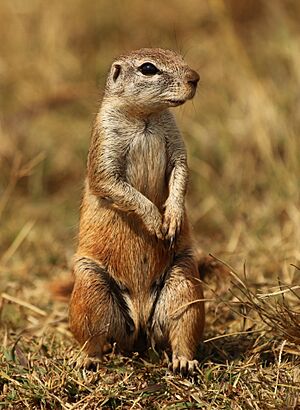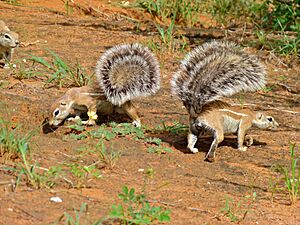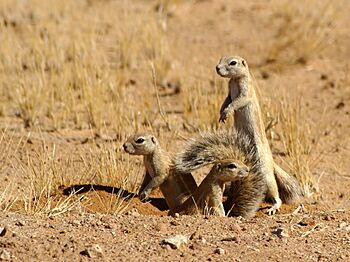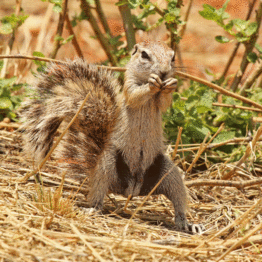Cape ground squirrel facts for kids
Quick facts for kids Cape ground squirrel |
|
|---|---|
 |
|
| At Krugersdorp Game Reserve, South Africa | |
| Conservation status | |
| Scientific classification | |
| Genus: |
Geosciurus
|
| Species: |
inauris
|
 |
|
| Cape ground squirrel range | |
| Synonyms | |
|
Xerus inauris |
|
The Cape ground squirrel (Geosciurus inauris) is a small, furry animal. It is also known as the South African ground squirrel. You can find it in the drier parts of southern Africa. This includes countries like South Africa, Botswana, and Namibia.
Its name, "Cape" ground squirrel, can be a bit confusing. This is because it lives in a much wider area than just the Cape region. The name likely helps tell it apart from other squirrels. For example, the eastern grey squirrel was brought to Cape Town from Europe.
People have also called this animal the fan-tailed squirrel.
Contents
What Does It Look Like?
The Cape ground squirrel has black skin. Its fur is short and stiff. The fur on its back is a cinnamon color. Its face, belly, and the sides of its neck and legs are white. Each side of its body has a white stripe. This stripe goes from its shoulders to its upper legs.
Its eyes are quite large and have white rings around them. Its ears are small. The tail is flat and covered with white hair. It also has two black bands near its base.
Male and female Cape ground squirrels look very similar. Males are usually a bit heavier and longer than females. They weigh between 423 and 649 grams (about 1 to 1.4 pounds). Females weigh between 444 and 600 grams (about 1 to 1.3 pounds). Males are about 42 to 47 centimeters (16 to 18 inches) long. Females are about 43 to 44 centimeters (17 to 17.5 inches) long.
Female squirrels have two pairs of milk glands on their belly. These are for feeding their babies. Ground squirrels shed their fur once a year. This happens around August to September and March to April.
Where Do They Live?
The Cape ground squirrel lives across southern Africa. You can find them in Botswana, South Africa, Lesotho, and Namibia. They are found in most of Namibia, but not along the coast. In Botswana, they live in the central and southwestern Kalahari Desert. In South Africa, they are common in the central and north-central areas.
How Do They Live?
Cape ground squirrels mostly live in dry or semi-dry places. They like open grasslands with hard ground. You can also find them in bushes near dry lake beds. They might even live in farm areas.
These squirrels are active during the day. They do not hibernate (sleep through winter). They are good at digging. They live in groups of burrows (underground tunnels). These burrow systems can be quite large. They usually have 2 to 100 entrances.
Burrows help keep the squirrels safe. They protect them from very hot or cold weather. They also hide them from predators. Even so, squirrels spend most of their day feeding above ground.
Staying Cool
Squirrels use their bushy tails to shade their heads and backs. This helps them stay cool in the hot sun. Research shows that raising their tails helps cool their skin. This makes them more comfortable while they look for food. Going into their burrows also helps lower their body temperature. In summer, they leave their burrows early to avoid the heat. In winter, their bodies warm up quickly when they come out. They also like to take dust baths.
What Do They Eat?
Ground squirrels eat many things. They munch on bulbs, fruits, grasses, and herbs. They also eat insects and shrubs. They search for food every day. They do not store food for later. They usually get enough water from their food. So, they don't often need to drink.
A squirrel's day is busy! About 70% of their time is spent eating. They spend 15-20% watching for danger. About 10% is spent socializing with other squirrels. They use the sun to help them remember where they hid food.
Sharing Homes
The burrows of Cape ground squirrels are sometimes shared. Meerkats and yellow mongooses also use them. Squirrels and meerkats seem to help each other. Mongooses and squirrels seem to just share space without much interaction.
Who Are Their Enemies?
Predators of ground squirrels include jackals, snakes, and monitor lizards. Ground squirrels can even smell the difference between predator droppings and other animal droppings.
When a predator threatens them, squirrels work together. This is called "mobbing." Several squirrels will rush at the predator. They use their bushy tails to try and block it. If the predator strikes back, the squirrels quickly move away. But often, mobbing works to scare the predator away.
Social Life
Cape ground squirrels live in groups. A group usually has two or three adult females. It also has up to nine younger squirrels of any gender. Plus, there are the females' babies. If a group gets too many females, it will split into smaller groups.
Adult males live separately from the females. They only join the female groups when the females are ready to mate. Male groups can have up to 19 males. These males are not related and usually don't fight. Within a male group, smaller groups of four or five males might form. These smaller groups change members every day.
Female groups live in their own burrow systems. Their home area is about 4 hectares (10 acres). They defend the main parts of their home area. Male groups have larger home areas. These areas cover the homes of several female groups.
In female groups, there is no boss. All members use the same areas for eating and sleeping. Male groups, however, have a pecking order based on age. Older males are usually in charge. Males usually don't fight much. They might do leaping displays instead. Male groups are not territorial. New members can join easily.
When a female is ready to mate, males will approach her. They will chase her and try to mate. The strongest males usually mate first. A female will mate with the same male several times. If a male hasn't mated with a female yet, he might try to stop her from mating with other males.
How Do They Talk?
When a ground squirrel sees danger, it makes a whistle-like sound. This is an alarm call. There are two types of alarm calls:
- A short, sharp "bi-jo" means serious danger.
- A medium-pitched "bi-joo" means less danger.
When squirrels are fighting, they make deep growls. Young squirrels make play calls, chirps in the nest, and squeaks when they protest.
Babies and Family
Cape ground squirrels can mate and have babies all year. But they mate most often in the dry winter months. The mother is pregnant for about 48 days.
When a female is about to have babies, she goes to a separate burrow. She stays there to care for her young. She returns to her group after her babies are old enough. If her babies are lost, she will also return to the group.
A mother usually has 1 to 3 babies in a litter. The babies are born without fur and are blind. They stay in the burrow for about 45 days. Their eyes open when they are about 35 days old. Seven days after coming out of the burrow, the babies can eat solid food. They stop drinking milk at about 52 days old.
Males are ready to mate when they are about eight months old. Females are ready at 10 months. Young males leave their birth groups. Young females usually stay with their birth groups.
Are They in Danger?
The Cape ground squirrel population is generally not threatened. However, in some areas, people see them as pests. This is because they can damage crops. People have also used poison to control them. This is sometimes done because of crop damage or worries about rabies.
Luckily, Cape ground squirrels live in protected areas. These include the Kgalagadi Transfrontier Park in Botswana and South Africa. They also live in Etosha National Park in Namibia.
Images for kids








